![]()
![]()
T H E N E W C A P I T A L
Written by Gevork Nazaryan
Tigran was a great admirer of great cities and he truly believed that the power of the state relied on the power of strong and prospering cities. The capital city of Artašat, established by King Artašes I, during the imperial period was isolated from the major trade routes and was now in the eastern corner of the vast empire. Tigran wanted to build a new city, a new capital. He envisioned the new capital full of grandeur -- a symbol of the New Armenia and the new order. The master architects searched for a strategically important location that would simultaneously fulfill multidimensional aspects for such an ambitious endeavor. The new capital --Tigranakert [Tigranocerta] -- the City of Tigran -- according to the vision, would become the new center of culture and civilization.
The city would also serve as a symbol of Greatness and Glory of the Emperor's victories. In the first years of the 70s BC, the Armenian Empire was at the zenith of its power. Tigran finally began the project of the building the dream City of Tigranakert. The location of the city was chosen after precise calculations and planning, taking into the lines of alignment on the crossroads of the most important trade routes of the ancient world. One such important road was the ancient Persian Royal Road, connecting Suza and Sardes -- from the East to the West.
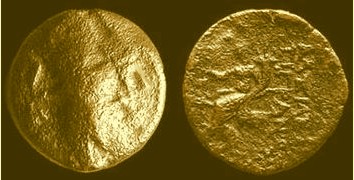
COIN OF THE QUEEN ERATO AND KING TIGRANES IV [8 BC - 1 AD]
OF THE
ARTAXIAD DYNASTY AS EQUAL LEADERS OF THE KINGDOM OF GREATER ARMENIA.
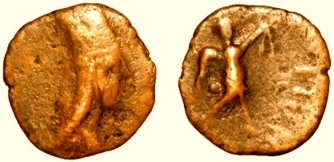
COIN OF TIGRANES III ARTAXIAD [20-8 BC] WITH THE GODDESS
ON THE OBVERSE.
The City of Tigranakert was situated in the Ałdznik Province of Greater Armenia, near the City of Amid. The metropolis was surrounded by huge, thick walls that were 50 cubits [25 meters] in height. A number of niches inside the wall served as stables, storage rooms, warehouses of armaments, ammunition, food supplies and other inventories. The Royal Palace was on the outskirts of the city, surrounded by beautiful gardens.
The King of Kings on the outset of laying the foundations of the Capital, invited nobles, craftsmen and laborers throughout the Empire in order to enrich the flavor of the new city. Many people moved from Cappadocia and Lesser Armenia, to Tigranakert. During its relatively short history, the new Capital had a population of around 100,000 citizens.
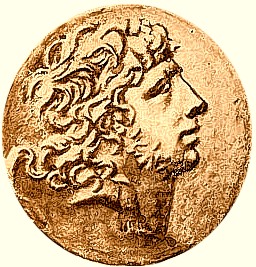
KING MITHRIDATES VI OF PONTUS -- LIKE TIGRAN
THE GREAT -- WAS
A STAUNCH
DEFENDER OF CLASSICAL CIVILIZATION AND VALUES
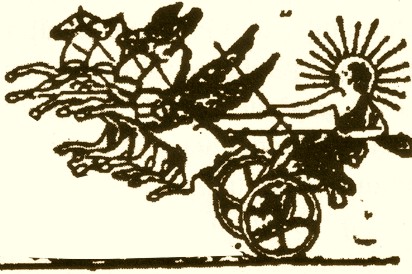
M I H R - H E L I O S - A P O L L O RIDING THE
QUADRIGA -- THE CELESTIAL
CHARIOT
OF
FOUR HORSES [FOUR CARDINAL DIRECTIONS]. SYMBOLS OF THE SUN GOD
[THE MITHRAIC STAFF, THE DOUBLE EAGLES, THE 8-POINTED STAR,
THE 5-SPOKE TIARA,
WERE INCORPORATED INTO THE ROYAL INSIGNIA OF
THE ARTAXIAD HOUSE. THE WORD
Θ Ε Ο Υ [GODLIKE] WAS PLACED ON
THE SILVER AND GOLD
COINS [BELOW] OF ARTAVASDES II.
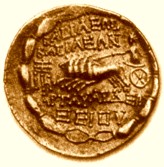
GODDESS OF VICTORY WEARING SEVEN-SPOKE SOLAR
CORONA
RIDES THE CELESTIAL FOUR-HORSED CHARIOT [FOUR SEASONS,
DIRECTIONS, ELEMENTS ETC.] FROM THE THE HOLY SIGN OF INFINITI
[GODHOOD] EMANATES THE LAUREL OF GLORY [APOTHEOSIS...].
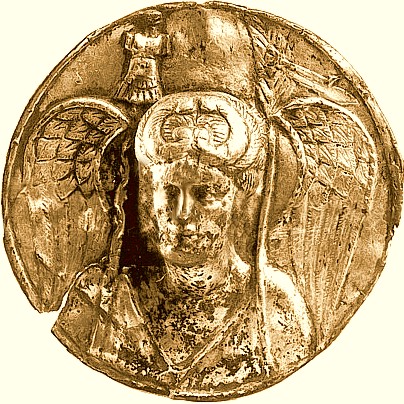
SILVER PENDANT OF A WINGED AND HORNED BUST OF THE GODDESS
[MOST PROBABLY -- A N A H I T -- THE GOLDEN MOTHER].
SECOND OR FIRST CENTURY BC. SISEAN, SIWNIK‛
PROVINCE.

T H E
T E M P L E
O F L I
G H T
ETERNALLY YOUTHFUL SUN GOD MIHR-MITHRAS [...SON OF THE INVISIBLE
FATHER...]
AS SUNRISE [L] -- TORCH POINTED UPWARDS [CAUTES]...AND SUNSET [R] --
TORCH POINTED DOWNWARDS [CAUTOPATES...THE WORD DEUS CONNOTING
THEIR DIVINITY WAS ALSO INSCRIBED NEXT TO
UP AND DOWN POINTING TORCHBEARERS]...NOTE THE MYTHIC ARALEZ DOG [L] --
CANIS MAJOR [DOG STAR...ANAHIT/VENUS]...AND...THE VISHAP/SERPENT...
THE SUN SETS [RETURNS] INTO THE PRIMORDIAL COSMIC WATERS/CHAOS
[ETERNAL FEMININE]...AREG-AKN MAYR MTAV...
THE GRAND TEMPLE OF LUSNT'AG [JUPITER] IN BAALBEK [BELL/WELL].
The city's markets were filled with traders and merchants doing business -- from all over the ancient world. Tigranakert quickly became a very important commercial, as well as cultural center of the Near East. The magnificent theater that was established by the Emperor, of which he was an avid devotee, conducted dramas and comedies mostly played by Greek as well as Armenian actors.
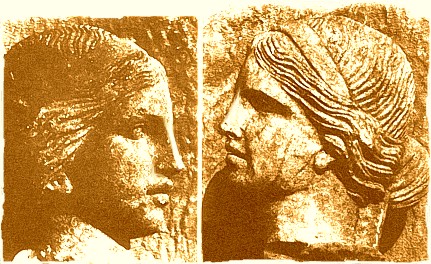
REMNANTS OF THE BEAUTIFUL STATUE OF ARMENIAN QUEEN SELENE
FROM ARSAMEIA.
'...Muses,
sweet-speaking daughters of Zeus Kronides and mistresses of song, sing next of
long-winged Moon! From her immortal head a heaven-sent glow envelops the earth
and great beauty arises under its radiance. From her golden crown the dim air is
made to glitter as her rays turn night to noon, whenever bright Selene, having
bathed her lovely body in the Ocean, puts on her shining raiment and harnesses
her proud-necked and glittering steeds. She swiftly drives them on as their
manes dazzle the evening, dividing the months. At mid-month her great orbit has
made its fullest swathe, and as she waxes a most brilliant light appears in the
sky. Thus to mortals she is a sign and a token. Hail, white-armed goddess,
bright Selene, mild, bright-tressed queen! And now I will leave you and sing the
glories of men half-divine, whose deeds minstrels, the servants of the Muses,
celebrate with lovely lips...'
-- HOMERIC HYMN TO SELENE,
VIITH CENTURY BC
His youngest son, Prince Artavazd, who would succeed the King of Kings, headed the theatre troop, which included a branch in the old Artaxiad capital of Artašat. As a major center of Hellenistic culture, the Capital attracted a great number of classical scholars who flocked to the patronage of Tigran the Great.
Plutarch wrote that Tigranakert was "a rich and beautiful city where every common man and every man of rank studied to adorn it." The Hellenistic culture during the Artaxiad dynasty had a strong influence and the Greek language was in fact the official language of the court. Tigran had divided Greater Armenia -- the nucleus of the Empire -- into four major strategic regions or viceroyalties, who were in their turn administered locally by the bdešxs or viceroys. After the bdešxs, came the naxarars or high nobility, in their turned followed by the lower nobility -- the sepuhs. The Azats, the most numerous members of the aristocracy followed.
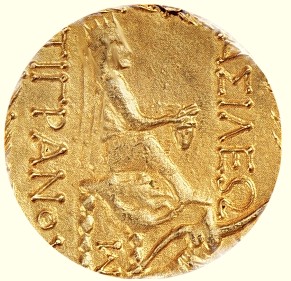
REVERSE SIDE OF ONE OF THE MANY GOLD
COINS OF THE ENTHRONED KING OF KINGS SHOWING
THE SYMBOLISM OF [DIVINATION] SEVERED HEAD.
THE SECOND LETTER AFTER BETA [OF ΒΑΣΙΛΕΩΣ]
IS ALPHA AND THE SECOND LETTER BEFORE SIGMA
IS OMEGA.
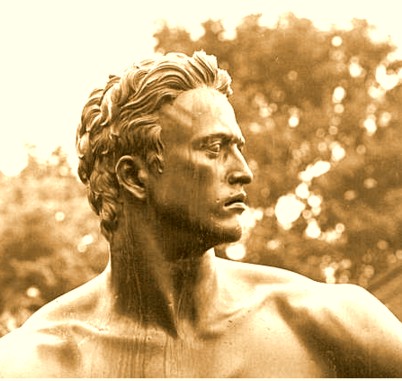
The azats or freemen were members of the Cavalry, the elite forces of the Imperial Army. The azats were trained from their childhood in fighting on horseback, highly skilled in the use of the sword, the bow, and the scimitar. Each azat cavalryman on the battlefield wore armor that extended to the horse itself. The Emperors Royal Guard was also selected from the members of the aristocracy.
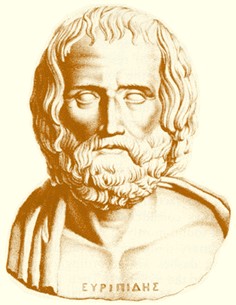
E U R I P I D E S [CA. 480-406 BC]. THE GREAT CLASSICAL
PLAYWRIGHT.
Ε Υ Ρ Ι Π Ι Δ Ο Υ Β Α Κ Χ Α I
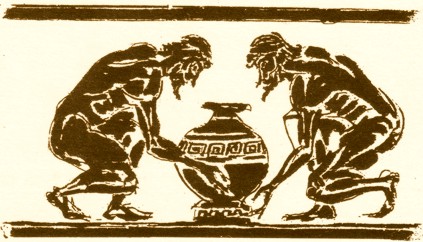
ARTAVAZD II -- LIKE HIS FATHER -- WAS A LEARNED MAN OF CULTURE
AND SCIENCE.
A DEDICATED PATRON OF CLASSICAL CULTURE -- PLUTARCH WROTE THAT
KING ARTAVAZD II ORGANIZED THE STAGING OF EURIPIDES'
TRAGEDY -- T H E B A C C H A E -- IN CAPITAL A R T A X
A T A
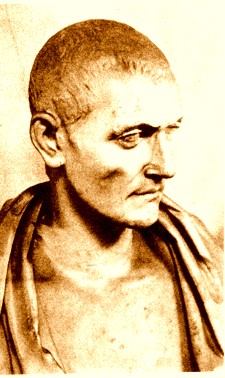
"The Romans make a desert...
and call it peace..."
- - TACITUS
![]()
MITHRAIC SYMBOL OF IMMORTALITY
INSCRIBED ON THE SILVER AND GOLD COINS
OF THE ARMAN KINGS
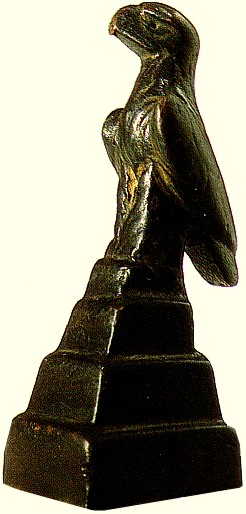
STATUE OF AN EAGLE ON TOP OF 3+1 [FOUR] STEP PYRAMID
FROM THE OLD CAPITAL ARTASHAT [ARTAXATA].
SECOND CENTURY BC. THE HOLY SIGN OF THE SUN [ORION] CULT.

THIS SYMBOL OF THE EAGLE ON TOP OF A MOUNTAIN
STRUCK ON THE COINS OF THE IMPERIAL MINT BY THE KING OF KINGS.
THE SYMBOL IS AN ARCHAIC PRIMORDIAL ARCHETYPICAL TOTEM GOING BACK
ALL THE WAY TO THE FIRST SETTLED COMMUNITIES IN ARMENIA.


CLASSIC VALUES.
Unfortunately the dream of Tigran of every booming Capital, with many
ambitious projects and plans was caught short in 69. That year the Romans,
headed by pro consul Lucullus, were able to make a breakthrough in the western
frontier, in several small skirmishes defeating the Pontic forces under
Mithridates. When Lucullus' cohorts reached the Capital, several of the
non-Armenian soldiers stationed in Tigranakert opened the main gates of the
city. The Romans cared little about the Hellenistic high ideals, which was
evident in the barbarous looting and the pillaging of city's cultural wealth.
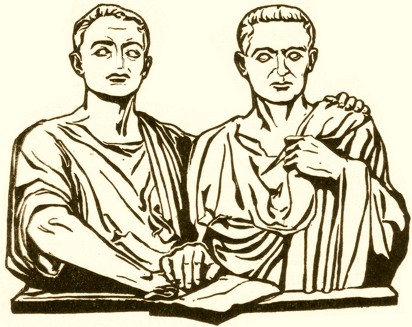
CLASSICAL PHILOSOPHERS. THE LIGHT OF ANCIENT WISDOM WOULD BE
REKINDLED
WITH T H E C O M I N G O F T
H E R E N A I S S A N C E
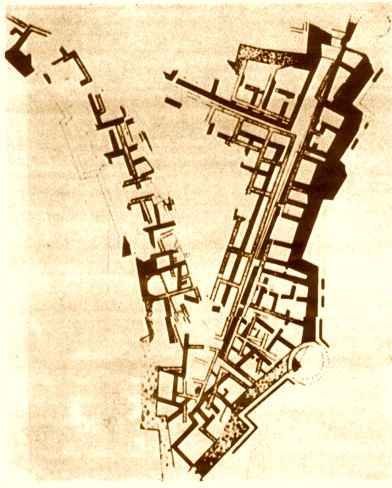
GENERAL PLAN OF ARTAXATA. THE OLD ARTAXIAD CAPITAL WAS
ERECTED
ON STRATEGIC BASIS [EASTERN BANKS OF ARAXES RIVER] BY ARMENIAN MASTER
ARCHITECTS IN THE FORM OF DELTOID ISOSCELES...NUMEROUS BEAUTIFUL SACRED
OBJECTS WERE UNEARTHED FROM MULTILAYER CAPITAL DURING THE MANY
DECADES OF EXCAVATIONS BY VARIOUS ARCHAEOLOGICAL EXPEDITIONS.
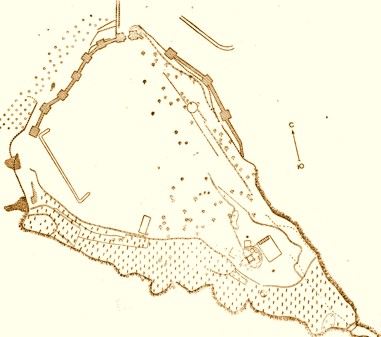
GENERAL PLAN OF GARNI INCLUDING, THE MITHRĆVM,
THE CASTLE AND THE BATHS. THE NATURAL FORM OF THE
COMPLEX IS AGAIN [SPECIFICALLY CHOSEN] ISOSCELES DELTA.
THE BELOW GARNI GORGE [GARNOY DZOR] IS A NATURAL WONDER
IN OF ITSELF WITH THE SEEMINGLY CHISELED MAN MADE [BUT NATURAL]
LONG AND SMOOTH VERTICAL SLABS [SIM. TO THOSE IN YOSEMITE
NATIONAL PARK WILDLIFE PRESERVE].
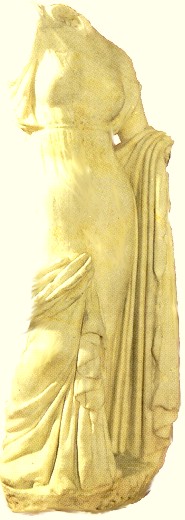
ONE OF THE FEW SURVIVING MARBLES OF THE BEAUTIFUL [RECORDED BY
THE CLASSICAL HISTORIANS AS -- P‛AP‛KASUN
TIKNAYK‛
HAYOC‛ AŠXARHI
-- LIT. PETITE ARMENIAN NOBLE MAIDENS] GODDESS ASTŁIK
FROM OLD CAPITAL ARTAXATA FOUND DURING THE ARCHAEOLOGICAL EXCAVATIONS.
II-I CENTURIES BC. LIKE MANY FREESTANDING STATUES THE HEAD IS MISSING AND
ONLY THE TORSO HAS BEEN PRESERVED. IT IS ALSO POSSIBLE THAT THE HEAD WAS
SEVERED AS BOOTY AS IT WOULD PROBABLY BE ADORNED WITH A CROWN MADE OUT
OF PRECIOUS METALS AND ADORNED WITH PRECIOUS STONES...

RESTORATION OF THE HALL OF DEIFIED ANCESTORS WITH
THE HAZARSHEN
ROOF THAT DREW IN THE ASTRAL LIGHT THROUGH THE SACRED OCTAGON -
OCTAGRAM PATTERN [TWO OVERLAPPING SQUARES
UT'/REGENERATION/INFINITI/ORDER EMERGING FROM VOID/CHAOS]
FOUR COLUMNS UNITE AS PILLARS TO FORM THE EQUILATERAL CROSS.
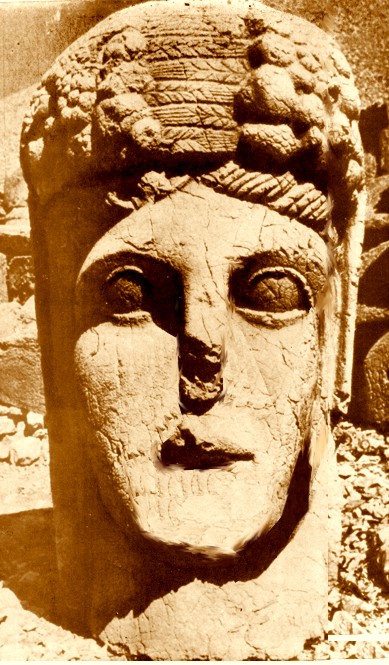
ANAHIT. THE SURVIVING HEAD OF THE MOTHER GODDESS IN THE
SACRED MOUNTAIN PANTHEON. AS LATE AS XIXTH CENTURY [SEE BELOW] WAS
STILL IN TACT...ATTACHED TO THE BODY OF THE ENTHRONED GODDESS...
NOTE WHEAT, FLOWERS AND FRUIT [SYMBOLS OF FERTILITY, ABUNDANCE
AND MOTHER NATURE IN GENERAL] STRANDS WOVEN AS A
REEF AND WORN AS A CROWN ON THE HEAD.
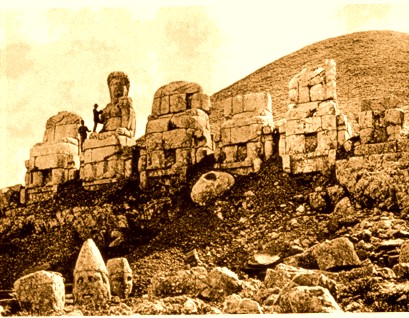
THE HOLY MOUNTAIN-PANTHEON. PHOTO TAKEN IN 1882. NOTE ONE OF THE
ARCHAEOLOGISTS [TO GIVE YOU THE PERSPECTIVE OF THE SIZE OF
THE STATUES] OF THE GERMAN EXCAVATION TEAM.
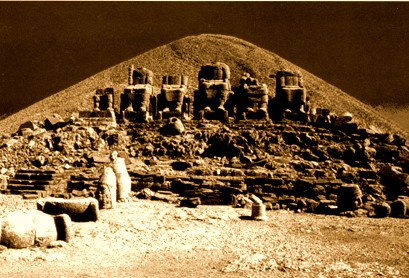
ALREADY BY MID XXTH CENTURY ALL THE STATUES OF THE GODDESS AND
THE GODS WERE 'DECAPITATED' WITH HEADS DEPOSED ROLLED OVER OR
UPRIGHT IMMEDIATELY NEXT TO THE CONSECRATED STATUES.

STAR ALIGNMENT IN THE CONSTELLATION OF LEO IN 63 BC. PHOTO
TAKEN IN 1883.
READ DETAILED EXPLANATION ON THE LAST PAGE OF THIS CHAPTER.
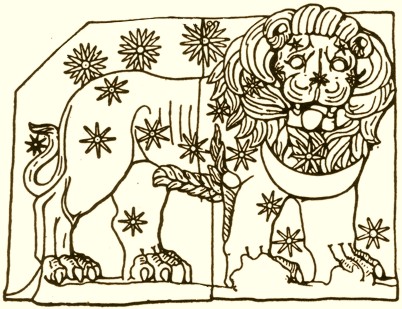
ONE OF THE SURVIVING RELIEFS OF THE CONSTELLATION OF LEO
[LIKE THE EAGLE -- A MITHRAIC SOLAR SYMBOL] MADE BY ARMENIAN
COURT SEER ASTROLOGERS FROM MOUNT NEMRUD -- THE SACRED
PANTHEON OF ORONTID [ERVANDUNI] KINGS OF LESSER ARMENIA.
BLUE BLOOD COUSINS OF THE ARTAXIADS OF GREATER ARMENIA
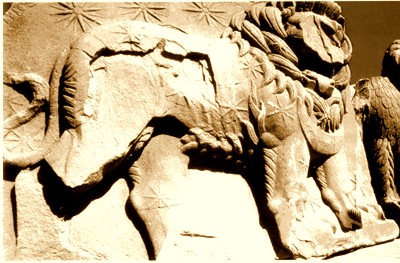
THE MARVELOUS CARVING TODAY...
After the plunder, that included the destruction of statues and temples, the city was set ablaze. The abundant quantity of gold and silver was carried off to Rome as war booty. Lucullus took the most of the gold and silver from the melted down statues, pots, cups and other valuable metals and precious stones. Most of the citizens during the pillage simple fled to the countryside. The newly established theatre building was also destroyed in the fire. The great city would never recover from this devastating blow.
|
|